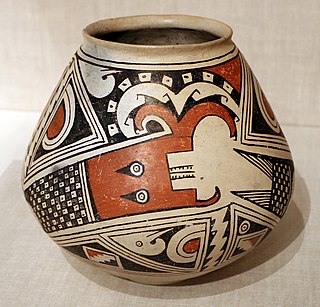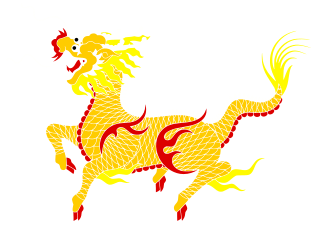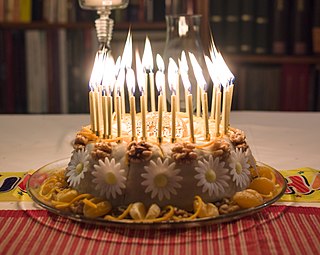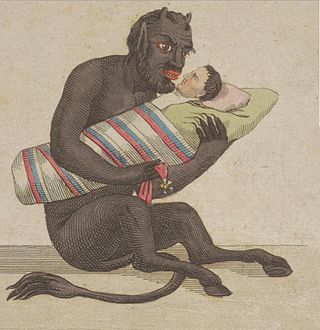
The Horned Serpent appears in the mythologies of many cultures including Native American peoples, European, and Near Eastern mythology. Details vary among cultures, with many of the stories associating the mystical figure with water, rain, lightning, thunder, and rebirth. Horned Serpents were major components of the Southeastern Ceremonial Complex of North American prehistory.

A kobold is a mythical sprite. Having spread into Europe with various spellings including "goblin" and "hobgoblin", and later taking root and stemming from Germanic mythology, the concept survived into modern times in German folklore.

The qilin is a legendary hooved chimerical creature that appears in Chinese mythology, and is said to appear with the imminent arrival or passing of a sage or illustrious ruler. Qilin are a specific type of the lin mythological family of one-horned beasts. The qilin also appears in the mythologies of other Chinese-influenced cultures.

A nian beast is a beast in Chinese mythology. According to Chinese mythology, the nian lives under the sea or in the mountains. The Chinese character nian more usually means "year" or "new year". The earliest written sources that refer to the nian as a creature date to the early 20th century. As a result, it is unclear whether the nian creature is an authentic part of traditional folk mythology, or a part of a local oral tradition that was recorded in the early 20th century. Nian is one of the key characters in the Chinese New Year. Scholars cite it as the reason behind several practices during the celebration, such as wearing red clothing and creating noise from drums and fireworks.

A birthday cake is a cake eaten as part of a birthday celebration. While there is no standard for birthday cakes, they are typically highly decorated layer cakes covered in frosting, often featuring birthday wishes and the celebrant's name. In many cultures, it is also customary to serve the birthday cake with small lit candles on top, especially in the case of a child's birthday. Variations include cupcakes, cake pops, pastries, and tarts.

The kallikantzaros is a malevolent creature in Southeast European and Anatolian folklore. Stories about the kallikantzaros or its equivalents can typically be found in Greece, Bulgaria, Turkey, Serbia, Albania, Bosnia, and Cyprus. Kallikantzaroi are believed to dwell underground but come to the surface during the twelve days of Christmas, from 25 December to 6 January.
Magical creatures are an aspect of the fictional Wizarding World contained in the Harry Potter series and connected media originally created by British author J. K. Rowling. Throughout the seven main books of the series, Harry and his friends encounter many of these creatures on their adventures in Hogwarts, the Forbidden Forest, or other locations throughout the Wizarding World. In addition, students learn to take care of creatures such as hippogriffs and unicorns in the Care of Magical Creatures class at Hogwarts. Rowling has also written Fantastic Beasts and Where to Find Them, a guide to the magical beasts found in the series, and based on the fictional textbook of the same name written by Newt Scamander and used by students at Hogwarts.

A chort is an anthropomorphic malign spirit or demon in Slavic folk tradition. Chorts are often depicted identically to Christian devils, with horns, hooves, and a skinny tail. In Slavic mythology, a singular Chort is sometimes identified as a son of the god Chernobog and the goddess Mara. Likewise, in Ukraine mythology, Chorts were originally the priest of Chernobog. In folk Christianity, they are considered lesser minions of Satan.

A Panther is a creature in ancient legend that resembles a big cat with a multicoloured hide.

Hercules and the Amazon Women is the first television movie in the syndicated fantasy series Hercules: The Legendary Journeys and marked the debut of Kevin Sorbo as the titular character Hercules and co-starred Anthony Quinn, Michael Hurst, Roma Downey and Lucy Lawless.

Candlemas, also known as the Feast of the Presentation of Jesus Christ, the Feast of the Purification of the Blessed Virgin Mary, or the Feast of the Holy Encounter, is a Christian feast day commemorating the presentation of Jesus at the Temple by Joseph and Mary. It is based upon the account of the presentation of Jesus in Luke 2:22–40. According to the Old Testament rules in Leviticus 12, a woman was to be purified by presenting a lamb as a burnt offering, and either a young pigeon or dove as sin offering, 33 days after a boy's circumcision. The feast falls on 2 February, which is traditionally the 40th day of and the conclusion of the Christmas–Epiphany season.

"Hind Horn" is a traditional English and Scottish folk ballad.

Aoandon, or Aoandō is a creature illustrated by Toriyama Sekien in his Konjaku Hyakki Shūi. It was meant to represent the spirit that appeared during the game Hyakumonogatari Kaidankai, after the last story was told. The candles in the room during these meetings were often placed in blue-paper andon lamps in order to create an eerie atmosphere, hence this creature's name.

Kūčios or Kūtės is the traditional Christmas Eve dinner in Lithuania, held on December 24. The meal is a family occasion which includes many traditions of both pagan and Christian origin. Some traditions are no longer widespread and usually Lithuanians just enjoy dinner with relatives and friends while the main events and festivities are left for Christmas Day.
The Nuberu, Ñuberu, Reñubeiru or Nubeiru, Nubero (Castilian) or Nubeiro (Galician) -literally "The Clouder"- is a character of Asturian, Cantabrian, Galician and Leonese mythology. According to Asturian mythology, the Nuberu, is the divinity of clouds and storms.

Yan-gant-y-tan is the name of a demon from Brittany, France.

Bedikat chametz, or bedikas chametz is the Mitzva to search for chametz before the Jewish Holiday of Passover. The search takes place after nightfall on the evening before Pesach.

The Badalisc is a mythical creature of the Val Camonica, Italy, in the southern central Alps. The Badalisc is represented today as a creature with a big head covered with a goat skin, two small horns, a huge mouth and glowing eyes.

Christmas in Iceland (Jól) starts four weeks before proper Christmas, which begins on 24 December (Aðfangadagur) and ends thirteen days later on 6 January.
The muki is a goblin-like creature in the mythology of the Central Andes in Bolivia, Peru, Ecuador and Colombia. He is known to be a miner and his existence is constrained to underground spaces: The muki lives inside the mines.
















